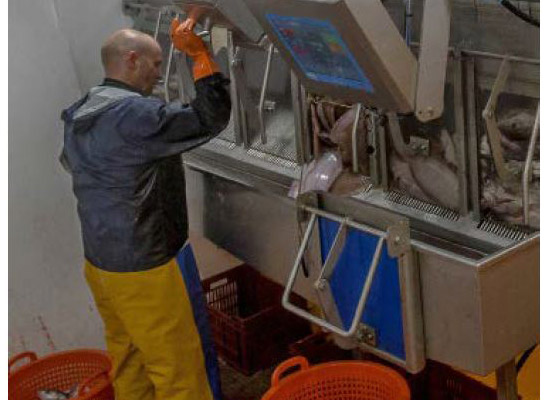Fish can be weighed fairly accurate on a heaving sea. But more accurate still is possible with a new measurement method.
Tekst Jeroen Akkermans Foto Penko
 When standing on a scale in an accelerating lift one sees increase his weight.
And just decreasing when the lift accelerates on its way down. Corners also spoil the game when it comes to your weight: on an inclined plane the pointer moves differently compared with the one on a flat surface.
When standing on a scale in an accelerating lift one sees increase his weight.
And just decreasing when the lift accelerates on its way down. Corners also spoil the game when it comes to your weight: on an inclined plane the pointer moves differently compared with the one on a flat surface.
On the high seas
Fishermen want to weigh the fish they caught on their heaving and rolling ship, need to correct for it - the cost for weighing ashore can be quite high. Directly besides the crates for the fish - with a load cell underneath - often a block is mounted
with its own load cell underneath that continuously records the weight. Under calm conditions the weight of that block is equal to the gravity thereon: roughly fifty Newton for a five kilograms mass. Once on the high seas, that weight can change with
a certain percentage. The conclusion is then: the weight of the crate with fish changes with the same factor, requiring a correction.
Measurement error
In practice, however, fishermen must assume a measurement error of 0.2 percent, forcing them to add fish, says Vincent van der Wel, engineer at Penko Engineering. "That is one hundred grams of fish in a fifty kilo crate." Penko has recently managed to
reduce the measurement error to roughly 0.04 percent. This means a fisherman "only" needs to add twenty grams, instead of one hundred. "A profit of eighty grams per crate: or one extra crate on 250 crates of fish."
One of the innovations allowing this is a remarkable one. Inside the company the idea came up to mount the same type of load cell for the one under the reference block and the load cell weighing the crates. In current systems the load cell under the block
is of a smaller type than the one under the crates because that permits for the use of a smaller block.
The main problem with different types of load cells is they have different behaviour. "They are not designed for the correction around the three axes on which a ship can move. As a result, they also behave differently. The load cells Penko uses too are
not made for reliable measurements on the high seas. But that does not matter since the measuring error for the block and for the crate is similar. "The correction factor, this way calculated for the crate, is the same error as the one necessary for
the measured weight of the crate."
Software innovations
In addition, there are software innovations. This way the measuring system - calculating a floating average weight - becomes a better distinction between peaks in the measured weight because of sudden ship movements and human actions, such as suddenly
adding a fish into a crate. "The calculation of the average then restarts instantaneously. Peaks caused by fish coming in a bin finally are filtered out. "It also becomes a calculated floating average weight in a smarter and faster way. We measure
the weight 1600 times per second, so the average at a calm sea is calculated over a period of a quarter second, on a rough sea may be in one and a half second. Current systems use in both cases half a second, making them less accurate."
Download the Article